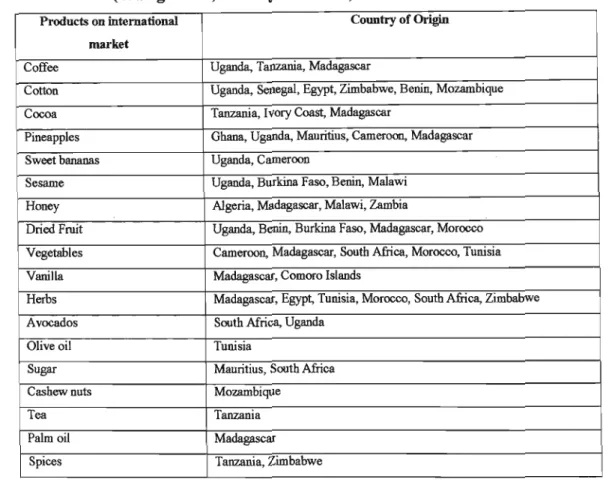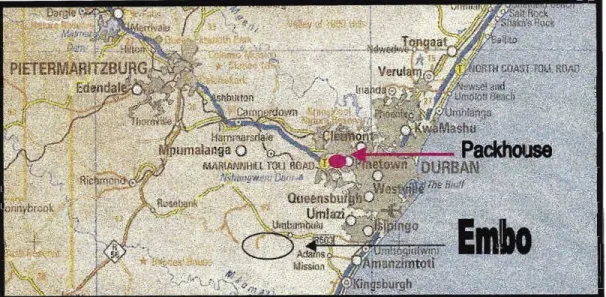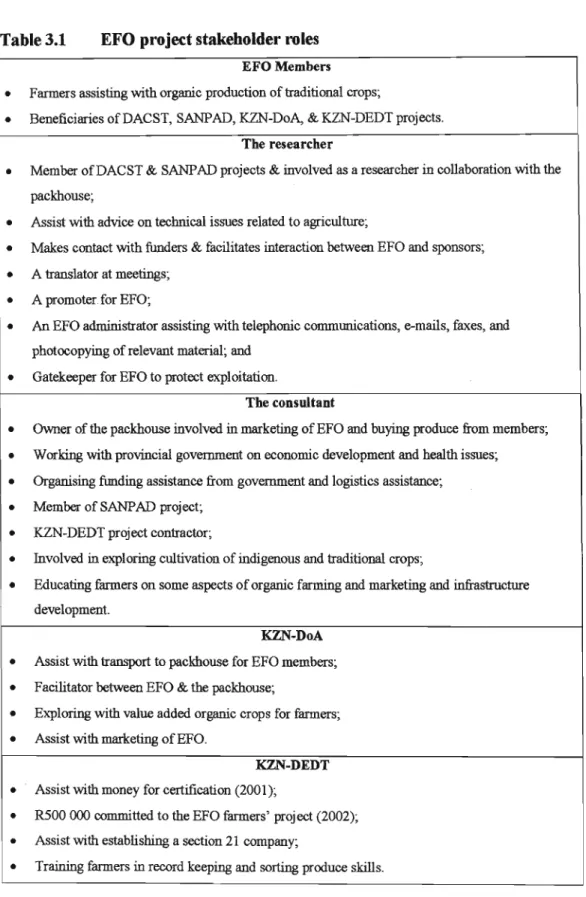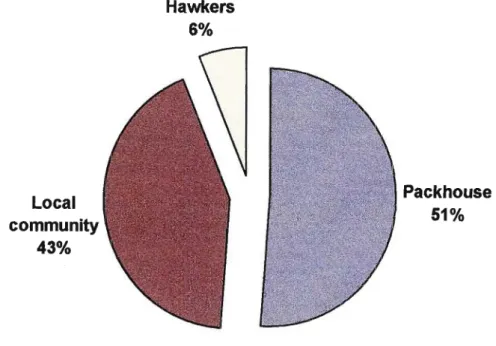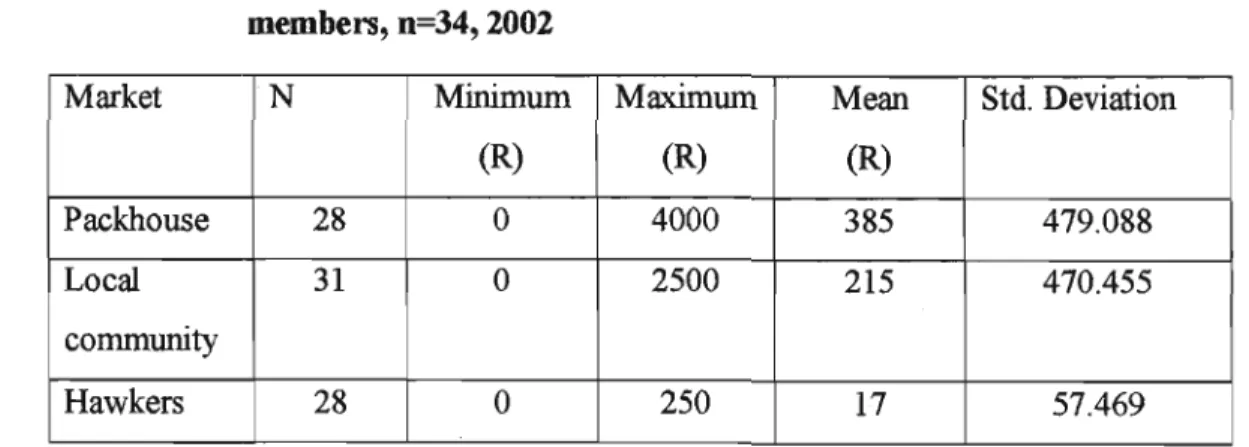Farmers obtained a slightly higher price for crops sold to the packing house compared to the other two markets. Expressed opinions and conclusions are the author's and should not necessarily be attributed to NRF.
Importance of the study
Participatory action research will be conducted to evaluate the sustainability of the agricultural livelihoods of EFO members through the exploration of the marketability and profitability of their organic products. Research will be undertaken to investigate whether EFO members can identify sustainable urban and peri-urban market opportunities for their products.
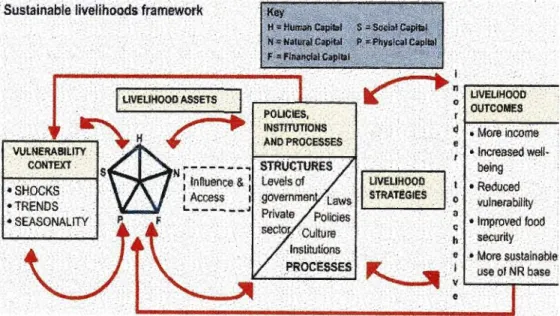
Statement of the problem
Sub-problems
Hypothesis
Study limitations
Sustainable livelihood: A livelihood is sustainable when it is able to continuously maintain or improve the current standard of living without undermining the natural resource base. Sustainable Livelihood Analysis: It is an analysis of livelihoods using the core principles of livelihood analysis which can be summarized as being people-focused, responsive and participatory, working at multiple levels, working with partners, dynamic be, as well as taking a broad view. of sustainability.
Assumptions
Organisation of thesis
INTRODUCTION
Sustainable agriculture
The natural potential of plants, animals and the landscape is respected and quality in all aspects of agriculture and the environment is optimized (Walaga 2002, cited by Soe12002). Corporate style farming IS not- Provides employment and remunerative countryside to smallholder farmers, thereby exacerbating development that increases farmer capacity.
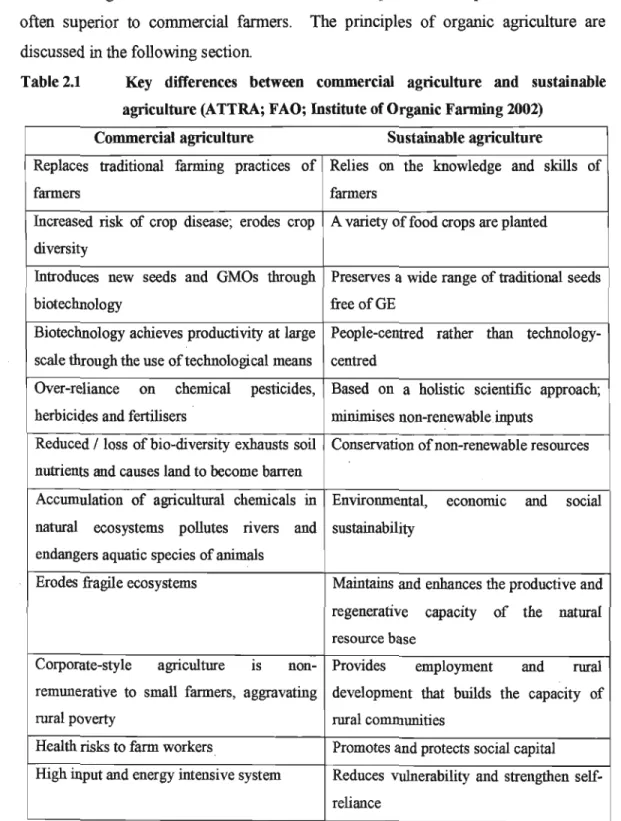
Principles of organic agriculture
Conservation of biodiversity
However, proponents of organic farming argue that labor demand, if more evenly distributed, can help stabilize employment (Auerbach 2002). The environmental benefits of organic farming have also attracted the attention of many non-governmental organizations (NGOs) and agricultural professionals, making this one of the main advantages of this farming method.
Natural plant nutrition
In Kenya, for example, organic farming practiced in small vegetable gardens involves the use of some selected agricultural technologies such as double digging, composting, the use of farmyard manure, green manures, liquid manure and composting with earthworms, among others (Mukhwana 2002). These agricultural practices of organic farming have a positive impact on the environment through soil nutrient management that maintains fertility, and in turn can increase the sustainability of rural communities' agricultural activities.
Mobilisation of skills, indigenous knowledge, and natural resources
There is a potential for organic product enterprises to support the livelihoods of the poor in most developing countries. The organic consumer is educated and aware of the health benefits of organic foods.
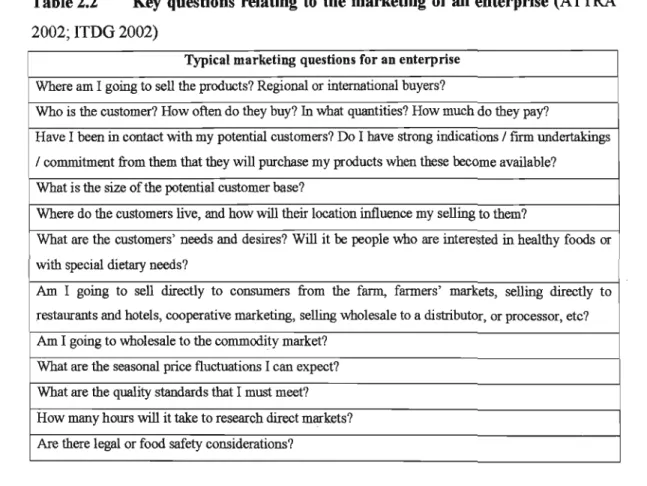
Synopsis
No projections have been made for the market in the developing countries, nor have markets been systematically identified for the developing countries' exports (FAO 2002). Embo is one of five traditional authorities in the region. The research was conducted in two of these tribal authorities' wards (Ogagwini and Ezigeni) which fall under the Embo community.
General information about Embo
The researcher then sought the assistance of the KZN-DoA in 2001 in order to assist the EFO with ensuring the transport of members' products from the community to packaging. The role of the KZN-DoA representative involved in the EFO project also included Zulu-English translation and facilitation between the EFO and the consultant/package.
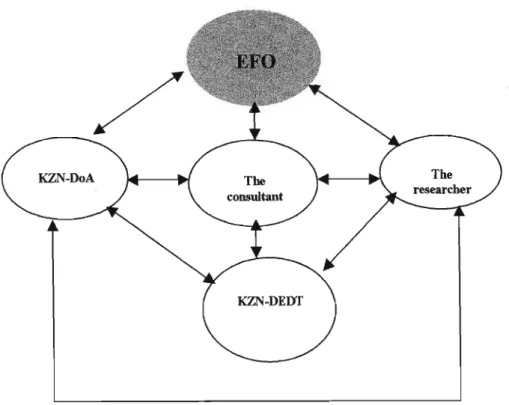
MEmODOLOGY
Population and sample selection
The research sample was purposively selected as a community in a rural area of KwaZulu-Natal that is representative of the most widespread groups of poor people and conditions in South Africa (Modi 2002). The majority of EFO members participated in the research tool parts of the information gathering stages.
Survey materials and approaches
- Feedback workshop
After the original questionnaire was developed, pilot testing was conducted with some EFO members to test the clarity of the questions. Exploring each of the four themes, there were three segregated groups that were systematically selected by the research team.
Data treatment and analysis
Action research was conducted as more understanding of the context of EFO activities increased. Action research was conducted leading to in-store investigation of the market opportunity for traditional organic products. Chapter six and chapter seven discuss the implications of these findings for each of the two subproblems respectively.
The objective of this study was to evaluate the sustainability of agricultural maintenance of the members of the Ezemvelo Farmers Organization (EFO) by examining the marketability and profitability of their organic products. Sub-problem two was to investigate whether production profitability could be improved for the EFO companies. A stakeholder analysis, which aimed to evaluate the history of the farmers' organization, as well as the roles, responsibilities and interests of each stakeholder involved in the farmers' organization and their quest for sustainable agricultural maintenance; And.
Household survey results
Farmers currently sell amadumbe, sweet potatoes and potatoes to the packing house (which sells to Pick 'n Pay), street vendors (who buy them from the farmers to later sell elsewhere) and locally (to neighbors and the community). The largest market for amadumbe currently used by EFO members is the packing house (51 percent), followed by local sales (43 percent) and finally sales to street vendors (six percent). The type of products the packing house accepts must be of a certain quality and size, otherwise the products will be rejected and returned to the farmers.
Farmers estimate that the loss due to produce rejected by packaging is high, resulting in high losses for farmers. The collective products are collected at the EFO chairperson's house and sent in packaging with transport provided by KZN-DoA. EFO is paid by the packer for accepted produce and rejected produce is sent to farmers.
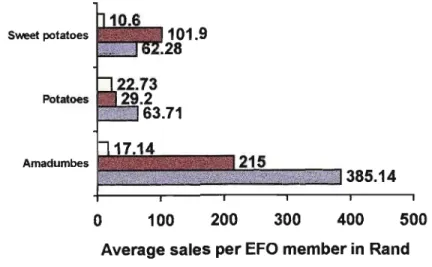
SLA results
The resources available to farmers were also identified as contributing to achieving the target. As one of the founders of EFO, the researcher is the gatekeeper for the farmers. First, the results of the market survey that was carried out were presented to the farmers.
It appeared that EFO members are not aware of the premium prices paid for organic crops. The lack of education of EFO members has made estimates of the costs of organic farming somewhat problematic. The supply of products to the warehouse is problematic for EFO members due to the unreliability of the Department of Agricultural Transport, the large amount of crops rejected by the warehouse, as well as delays in the payment of products.
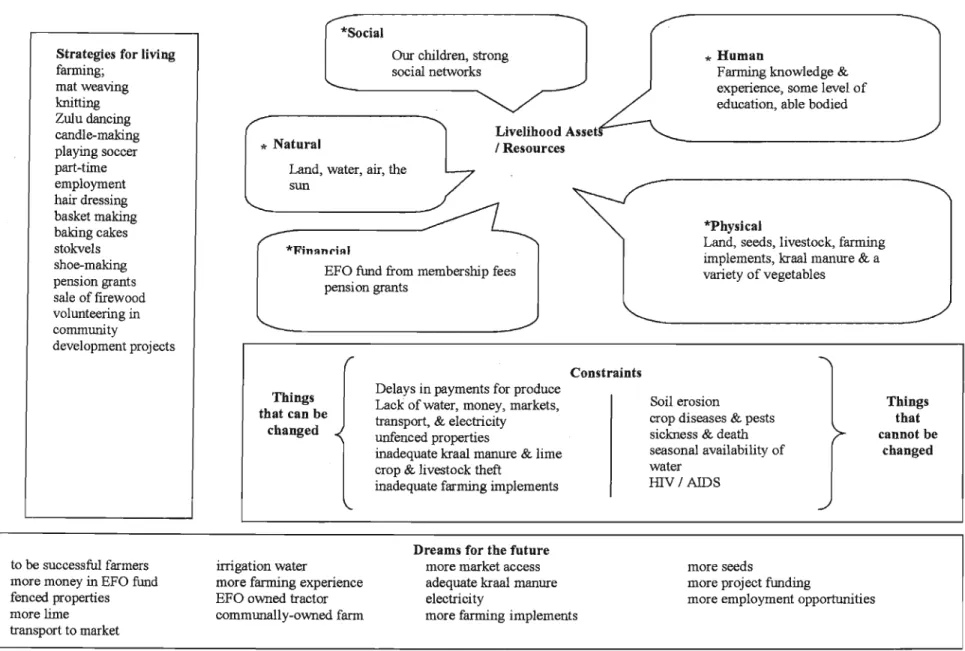
Conclusions
Fourth, KZN-DoA sponsors the transport of farmers' produce to the packing house in the interim. Finally, KZN-DEDT has assisted with certification costs and has now awarded a grant to a consultant for the Farmers' Organization Development Project. Farmers get slightly higher prices for produce sold to packers, but are unaware of the higher prices paid for organic produce by supermarkets such as Woolworths.
However, farmers and some stakeholders are not aware of the various research projects being carried out by the consultant ostensibly using EFO members as subjects of study and beneficiaries. Other direct contractual agreements that EFO members could enter into were identified as guesthouses, hunting lodges and restaurants. The research showed that EFO member farms were unprofitable due to high input costs and production losses.
Recommendations as a result of the conclusions
- Monitoring and evaluation of projects
- EFO members' business management skiDs development
- Improving EFO fann profitability
This will be a direct arrangement between farmers and their market and will minimize the problems currently experienced by EFO members. EFO members can benefit from this venture and learn the necessary skills to boost their income. This is especially true for the rural impoverished masses of South Africa, as evidenced by the case of EFO members.
EFO members mobilized themselves into a legally recognized group and obtained certification to engage in the sale of organic products. EFO members do not cost time and labor and estimates were used to calculate them and obtaining qualitative and quantitative information on the productivity and constraints on farming livelihoods was not easy due to the low education levels of the farmers. An improvement of the study would be to evaluate the value and profitability of the other traditional organic crops that EFO members produce and evaluate their marketability.
Implications for further research
Sanada WWW] URL http://reflect.actionaid.net (Adoolessa 25 bara 2002 argame) Ngqangweni S, Kirsten JF, Lyne MC fi Hedden-Dunkhorst B (1999). Sanada WWW] URL http://www.lboro.ac.uk/orgs/well/resources/well-studies/summaries-htmltask0069.htm (Adoolessa 22 bara 2002 argame). WWWdocument] URL http://www.undp.org (2 Adoolessa 2002 argame) Dhaabbata Barnootaa, Saayinsii fi Aadaa Dhaabbata Mootummoota Gamtoomanii (UNESCO) Inistiitiyuutii Barnootaa (2002).
CONSTITUTUION OF EZEMVELO FARMERS ORGANISATION
The President acts as Treasurer in the absence of the Treasurer unless the Treasurer's signature is required. The EFO bank account is opened in the name of the president, secretary and treasurer. The Ogagwini site chief is an ex-officio member of the executive committee and acts as a conciliator.
It consists of all members of the executive committee, all internal inspectors approved by the generating membership and suitably trained in a recognized institution, the quality control officer and the district head or deputy head for the Department of Agriculture (eg. -officio). A member that does not comply with the rules of the organic framework will be dealt with in accordance with the determinations of the certification body of organic agriculture, which include exclusion. The constitution will be amended in accordance with the requirements of the majority (two-thirds) of EFO members with voting rights.
APPENDIXB Household survey questionnaire
How do you determine the price for organic crops sold to markets other than pre-sale to the packing house. SHBJACK sold to hawkers blackjack SPHBJACK sold to packhuose blackjack SLAMARAN sold to local amaranthus SHAMARAN sold to hawkers amaranthus. SHBEANS sold to merchants beans SPHBEANS sold to packing house beans SLNUTS sol<;1 to local nuts SHNUTS sold to merchant nuts SPHNUTS sold to packing house nuts SLPUMP sold to local pumpkins SHPUMP sold to merchants pumpkins SPHPUMP sold to packing house pumpkins SLMAIZE sold to local corn.
IllIAMARAN value of amaranthus consumed by the household HHBONE value of beans consumed by the household. HHPOMP value of PUMPKIN consumed by the household HBMAIZE value of maize consumed by the household LOSSAMAD value of amadumbe losses. LOSSPOT value of potatoes losses LOSSPOT value of sweet potatoes losses LOSSbjack value of blackjack losses.
OTHERORG other organizations that sell organic crops around the area PRICEDIFF does the price of organic and inorganic crops differ: 1=no, 2=yes TOTLINC's total income from crops sold to locals. TOTIDNC Total Revenue from Crops Sold to Street Vendors TOTPHINC Total Revenue from Crops Sold to Packers TOTSELL Grand Total from All Crops Sold.
